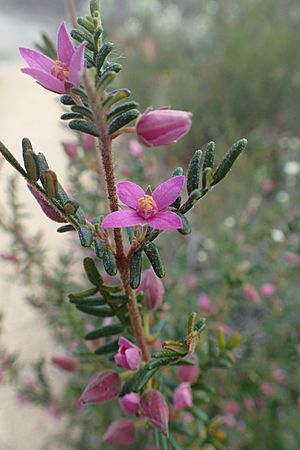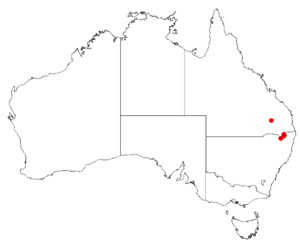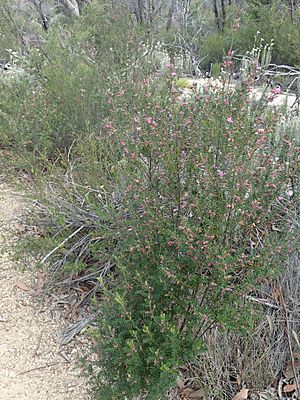Wyberba boronia facts for kids
Quick facts for kids Wyberba boronia |
|
|---|---|
 |
|
| Boronia amabilis in Girraween National Park | |
| Scientific classification | |
 |
|
| Occurrence data from Australasian Virtual Herbarium |
Boronia amabilis, also known as the Wyberba boronia, is a special plant found only in a small part of southern Queensland, Australia. It belongs to the citrus family, just like oranges and lemons! This plant is a shrub that stands tall with many branches. It has unique leaves and pretty pink flowers with four petals.
What it Looks Like
The Wyberba boronia is a shrub that grows straight up. It can reach about 3 m (10 ft) tall. Its many branches are covered with tiny, star-shaped hairs. These hairs can be white or reddish-brown. As the plant gets older, these hairs often disappear, making the branches smooth.
The leaves are 10–55 mm (0.39–2.2 in) long and 6–28 mm (0.24–1.1 in) wide. They are pinnate, which means they look like a feather with smaller leaflets branching off a main stem. Each leaf has between three and fifteen small, oval-shaped leaflets. The underside of these leaflets is usually hairy. The leaflet at the very end is 3–18 mm (0.1–0.7 in) long, and the others are a bit smaller.
The flowers are pink and grow in groups. You can usually find three to seven flowers together. They grow where the leaves meet the stem, which is called a leaf axil. Each group of flowers sits on a small stalk, called a peduncle, about 2–5 mm (0.08–0.2 in) long.
Each flower has four sepals, which are like small leaves that protect the bud. These sepals are narrow and shaped like an egg or a triangle. They are about 3.5–6 mm (0.1–0.2 in) long. The four pink petals are the showy part of the flower. They are usually 8–12 mm (0.3–0.5 in) long and 4–6 mm (0.2–0.2 in) wide. The underside of the petals is also hairy.
Inside the flower, there are eight stamens. These are the parts that produce pollen. They are different lengths, with some being slightly shorter than others. After the flowers, the plant produces small fruits. These fruits are smooth and measure about 4–5 mm (0.16–0.20 in) long and 2–3 mm (0.079–0.12 in) wide.
How it Got its Name
The Wyberba boronia was first officially described in 1963. A scientist named Stanley Thatcher Blake gave it its formal name, Boronia amabilis. He published his description in a scientific paper called Proceedings of the Royal Society of Queensland.
The second part of its scientific name, amabilis, comes from a Latin word. It means "lovely" or "lovable." This name perfectly describes the plant's pretty pink flowers!
Where it Lives
This special boronia plant grows in forests and woodlands. It prefers areas where the soil is made from granite rock. You can find it in a small area of south-eastern Queensland, between Wyberba and the nearby Girraween National Park.
Keeping it Safe
The Wyberba boronia is considered "near threatened" by the Queensland Government. This means that while it's not in immediate danger of disappearing, its numbers are low, and it needs to be watched carefully. The government protects it under the Nature Conservation Act 1992 to help make sure it stays safe for the future.


